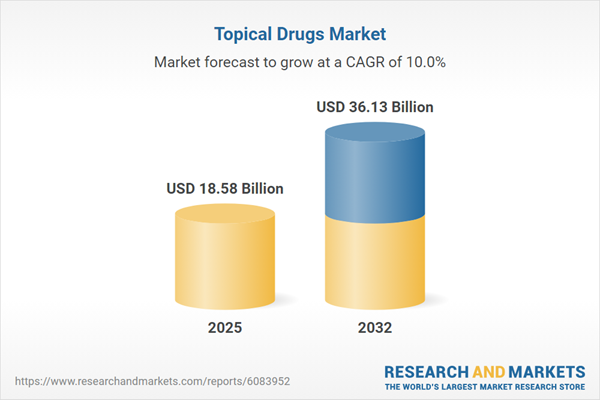Speak directly to the analyst to clarify any post sales queries you may have.
The topical drugs market is undergoing rapid evolution as pharmaceutical innovation, patient demand for advanced therapies, and healthcare digitization reshape sector priorities. Senior leaders navigating this space must align strategy with emerging clinical needs, operational risks, and shifting regulatory pressures.
Market Snapshot: Topical Drugs Market Growth and Outlook
Recent research reveals that the topical drugs market increased in value from USD 16.86 billion in 2024 to USD 18.58 billion in 2025, indicating solid momentum. Projections suggest this trend will continue, with the sector expected to achieve a 9.99% CAGR and reach USD 36.13 billion by 2032. Growth is primarily driven by scientific advances, higher rates of dermatological disorders, and increasing global demand for accessible topical therapeutics. These shifts encourage leadership to focus on pipeline agility and regional responsiveness as the market landscape diversifies.
Scope & Segmentation
- Formulation Types: Cream, gel, lotion, ointment, patch, and spray formulations are central, offering tailored delivery methods to suit specific therapeutic needs and user preferences.
- Indication Areas: Key focus areas include acne, eczema, fungal infections, and psoriasis, reflecting the broad spectrum of dermatological challenges addressed by topical therapies.
- Distribution Channels: Hospital pharmacies (both private and public), online pharmacies (marketplace and pure play), and retail pharmacies (chain and independent) drive access and market penetration across settings and geographies.
- Product Types: Both over-the-counter and prescription-based topical drugs are covered, enabling companies to target self-medication as well as clinician-directed care.
- End User Categories: Clinics, home care, and hospital settings are central customer groups, reflecting the importance of both professional healthcare providers and consumer-administered solutions.
- Regions Covered: The Americas (United States, Canada, Mexico, Brazil, Argentina, Chile, Colombia, Peru), Europe, Middle East & Africa (United Kingdom, Germany, France, Russia, Italy, Spain, Netherlands, Sweden, Poland, Switzerland, United Arab Emirates, Saudi Arabia, Qatar, Turkey, Israel, South Africa, Nigeria, Egypt, Kenya), and Asia-Pacific (China, India, Japan, Australia, South Korea, Indonesia, Thailand, Malaysia, Singapore, Taiwan) represent the primary regional markets, each with unique regulatory and demand dynamics impacting adoption and distribution.
- Technologies in Use: Advanced drug delivery systems, digital health integration, AI-guided formulation, and sustainable manufacturing drive product differentiation and operational resilience.
- Leading Companies: Industry benchmarks include Johnson & Johnson, Pfizer Inc., Novartis AG, Sanofi S.A., Bayer AG, GlaxoSmithKline plc, AbbVie Inc., Teva Pharmaceutical Industries Ltd., Galderma S.A., and LEO Pharma A/S, reflecting global competitive dynamics and innovation leadership.
Key Takeaways: Strategic Priorities in the Topical Drugs Market
- Companies are adopting pioneering drug delivery technologies, such as nanocarriers and 3D-printed dosage forms, to enhance patient experience and improve therapeutic outcomes.
- Regulatory shifts, particularly around generics and biosimilars, are enabling faster market entry, intensifying competition, and supporting broader access to care.
- Supply chain strategies are evolving, with many stakeholders adopting nearshoring models and local sourcing to minimize exposure to global disruptions and safeguard operational efficiency.
- Digital tools, including telemedicine integration and AI-enabled platforms, are being leveraged to improve prescription adherence, enable precise diagnosis, and extend product reach to underserved markets.
- Dynamic market segmentation by formulation, distribution channel, and end user is allowing organizations to align portfolios with specific patient groups and prioritize high-opportunity segments with tailored solutions.
- Sustainability considerations and value-driven collaborations, from eco-friendly packaging to strategic innovation partnerships, are increasingly shaping company trajectories and stakeholder engagement approaches.
Tariff Impact: Operational and Strategic Considerations
With the introduction of 2025 U.S. tariffs on active pharmaceutical ingredients and specialized packaging, procurement expenses and lead times have increased throughout the topical drug sector. Manufacturers are responding by sourcing supplies from local or regional providers, optimizing internal operations, and renegotiating distribution contracts. These measures aim to enhance supply-chain resilience, manage risk exposure, and support stable future growth.
Methodology & Data Sources
This analysis is grounded in in-depth primary research, including interviews with dermatologists, pharmacologists, and industry executives. Secondary data was extracted from peer-reviewed journals, regulatory guidance, industry white papers, and company financial reports. Triangulation and validation workshops ensure that findings are robust and strategically relevant.
Why This Report Matters
- Equips decision-makers to benchmark and optimize innovation strategies amid regulatory and market shifts.
- Provides actionable guidance for investment targeting high-growth technologies and therapeutic segments, informed by comprehensive stakeholder insights.
- Supports executive teams in mitigating risk and responding nimbly to pricing, supply chain, and regional market challenges.
Conclusion
The topical drugs market is in a transformative phase shaped by regulatory changes, clinical innovation, and increased patient focus. Stakeholders who act on timely insights will secure sustainable growth and sharpen their strategic positioning in this complex healthcare environment.
Table of Contents
3. Executive Summary
4. Market Overview
7. Cumulative Impact of Artificial Intelligence 2025
Companies Mentioned
The companies profiled in this Topical Drugs market report include:- Johnson & Johnson
- Pfizer Inc.
- Novartis AG
- Sanofi S.A.
- Bayer AG
- GlaxoSmithKline plc
- AbbVie Inc.
- Teva Pharmaceutical Industries Ltd.
- Galderma S.A.
- LEO Pharma A/S
Table Information
| Report Attribute | Details |
|---|---|
| No. of Pages | 183 |
| Published | October 2025 |
| Forecast Period | 2025 - 2032 |
| Estimated Market Value ( USD | $ 18.58 Billion |
| Forecasted Market Value ( USD | $ 36.13 Billion |
| Compound Annual Growth Rate | 9.9% |
| Regions Covered | Global |
| No. of Companies Mentioned | 11 |









